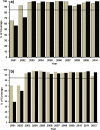Interruption of Onchocerca volvulus transmission in Northern Venezuela
- PMID: 24499653
- PMCID: PMC3856516
- DOI: 10.1186/1756-3305-6-289
Interruption of Onchocerca volvulus transmission in Northern Venezuela
Abstract
Background: Onchocerciasis is caused by Onchocerca volvulus and transmitted by Simulium species (black flies). In the Americas, the infection has been previously described in 13 discrete regional foci distributed among six countries (Brazil, Colombia, Ecuador, Guatemala, Mexico and Venezuela) where more than 370,000 people are currently considered at risk. Since 2001, disease control in Venezuela has relied on the mass drug administration to the at-risk communities. This report provides empirical evidence of interruption of Onchocerca volvulus transmission by Simulium metallicum in 510 endemic communities from two Northern foci of Venezuela, after 10-12 years of 6-monthly Mectizan (ivermectin) treatment to all the eligible residents.
Methods: In-depth entomologic and epidemiologic surveys were serially conducted from 2001-2012 in selected (sentinel and extra-sentinel) communities from the North-central (NC) and North-east (NE) onchocerciasis foci of Venezuela in order to monitor the impact of ivermectin treatment.
Results: From 2007-2009, entomological indicators in both foci confirmed that 0 out of 112,637 S. metallicum females examined by PCR contained L3 infection in insect heads. The upper bound of the 95% confidence intervals of the infective rate of the vector reached values below 1% by 2009 (NC) and 2012 (NE). Additionally, after 14 (NC) and 22 (NE) rounds of treatment, the seasonal transmission potential (±UL CIs) of S. metallicum was under the critical threshold of 20 L3 per person per season. Serological analysis in school children < 15 years-old demonstrated that 0 out of 6,590 individuals were harboring antibodies to Ov-16. Finally, epidemiological surveys made during 2010 (NC) and 2012 (NE) showed no evidence of microfilariae in the skin and eyes of the population.
Conclusions: These results meet the WHO criteria for absence of parasite transmission and disease morbidity in these endemic areas which represent 91% of the population previously at-risk in the country. Consequently, the two Northern foci are currently under post-treatment onchocerciasis surveillance status in Venezuela.
Figures


References
-
- WER. Progress towards eliminating onchocerciasis in the WHO region of the Americas: verification by WHO of elimination of transmission in Colombia. Wkly Epidemiol Rec. 2013;88:381–385. - PubMed
-
- Arends T, Rondon MF, Gonzalez M. Nuevo foco de oncocercosis humana en Venezuela. Gaceta Med Caracas. 1954;62:645–647. - PubMed
-
- Potenza L, Febres-Cordero R, Anduze PJ. Oncocercosis humana en Venezuela. Gaceta Med Caracas. 1948;56:219–220.
-
- WER. Progress towards eliminating onchocerciasis in the WHO region of the Americas in 2011: interruption of transmission in Guatemala and Mexico. Wkly Epidemiol Rec. 2012;87:309–315. - PubMed
-
- Peñalver LM. Estudio de un foco de oncocercosis en la región central de Venezuela. Determinación de Simulium metallicum y Simulium exiguum como transmisores de la enfermedad en Venezuela. Rev Venezolana Sanidad Asistencia Social. 1961;26:898–912.
Publication types
MeSH terms
Substances
LinkOut - more resources
Full Text Sources
Other Literature Sources

